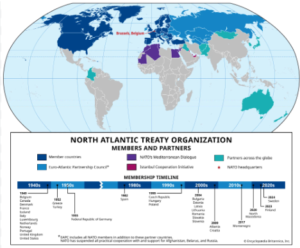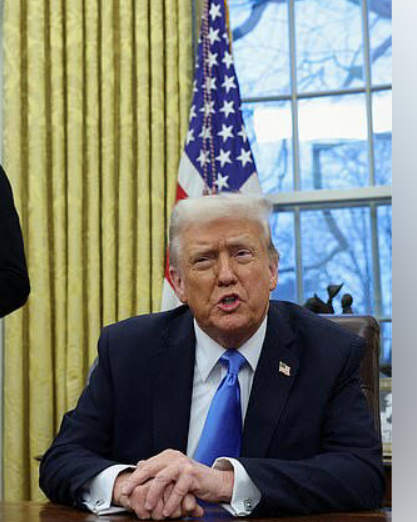By Joke Kujenya with reports from international media
UNITED STATES of America’s President Donald Trump has embraced the Russian President Vladimir Putin’s stance on Ukraine’s NATO membership, marking a dramatic shift in U.S. foreign policy.
He said the decision leaves Ukraine exposed to future Russian aggression, with President Volodymyr Zelenskyy warning that his country remains vulnerable without NATO’s protection.
Speaking to reporters at the White House, Trump confirmed that Ukraine will not be joining NATO.
He stated that “they’ve been saying for a long time that Ukraine cannot go into NATO, and I’m okay with that.”
His remarks come after a conversation with Putin that lasted over an hour, during which the two leaders discussed negotiations regarding the war in Ukraine.
The U.S. administration has further signalled a recalibration of its stance on the conflict.
Trump’s Defense Secretary, Pete Hegseth, dismissed the prospect of Ukraine becoming a NATO member, calling it “not a realistic outcome of a negotiated settlement.”
He also described a return to Ukraine’s pre-2014 borders as “unrealistic.”
The remarks align with Trump’s long-held skepticism about NATO and its obligations, reinforcing predictions that he would diverge sharply from Joe Biden’s approach.
During a speech at the Munich Security Conference, Zelenskyy reacted to Hegseth’s comments by stating that if Ukraine cannot join NATO, it would need to double its army to 1.5 million troops to defend itself.
He criticised past U.S. assurances of eventual NATO membership, calling them “just talk.”
Meanwhile, U.K. Prime Minister Keir Starmer reiterated Britain’s commitment to Ukraine’s NATO aspirations, describing them as “irreversible.”
Vice President JD Vance, speaking to NATO leaders, cast doubt on Europe’s ability to uphold democratic values.
“The biggest threat to Europe is not Russia or China, but the retreat from fundamental values shared with the United States,” he said.
His remarks reflect a broader shift in Washington’s rhetoric, moving away from a singular focus on Russia and towards criticism of European leadership.
Trump has also initiated direct negotiations with both Ukraine and Russia.
His Treasury Secretary, Scott Bessent, visited Kyiv to discuss potential agreements involving Ukraine’s natural resources in exchange for continued military support.
This aligns with Trump’s consistent argument that the U.S. should receive tangible benefits for its financial and military aid to Ukraine.
The Trump administration has pressed NATO allies to increase their defence spending.
Hegseth told European leaders that they must allocate 5% of their GDP to defence, a figure exceeding current contributions by all NATO members, including the U.S., which spends approximately 3.5%.
The issue of Ukraine’s NATO membership remains at the heart of the geopolitical crisis.
Since Russia’s invasion nearly three years ago, Kyiv has sought NATO’s protection.

Biden had promised eventual membership but concerns over Article 5 — the mutual defence clause — have made Ukraine’s accession contentious.
If Ukraine were to join NATO, any Russian attack would trigger a collective military response, raising fears of a global conflict.
Vance suggested that Washington would leverage both economic sanctions and potential military action against future Russian aggression.
His remarks raise questions about the effectiveness of sanctions, given that previous U.S. measures have not significantly hampered Russia’s economy.
Meanwhile, Trump has signed an executive order introducing sweeping new tariffs under the banner of “reciprocal tariffs.”
The measures will allow the U.S. to impose tariffs matching those levied on American exports by other nations.
The policy, which echoes the protectionist stance of former President William McKinley, is expected to trigger trade disputes.
Trump defended the tariffs, stating, “Tariffs are good, tariffs are great actually,” while acknowledging that U.S. prices “could go up.”
A senior White House official explained that the policy will account for non-tariff barriers such as value-added taxes, subsidies, regulatory hurdles, and currency manipulation.
Trump has repeatedly criticised the European Union’s VAT system, calling it “brutal.”
The administration has left room for negotiation, suggesting that the tariffs could be revised if foreign governments agree to lower trade barriers.
The latest developments highlight a profound transformation in U.S. foreign and economic policy under Trump.
By rejecting Ukraine’s NATO bid, engaging in direct talks with Putin, and introducing aggressive trade measures, the administration is steering the country towards a strategy that prioritises economic and military self-interest over traditional alliances.
The implications for global stability and America’s role in international affairs remain uncertain.





